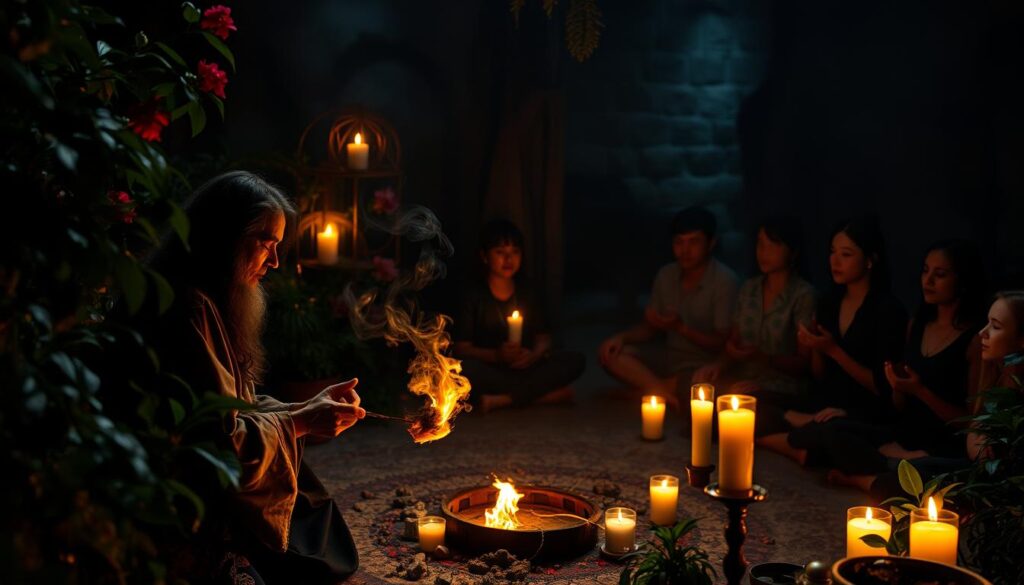Shamanism is a timeless practice that bridges the gap between ancient wisdom and modern healing techniques. Rooted in deep ancestral memory, it transcends formal religion, offering a unique connection to spirit and nature. This spiritual practice has evolved over centuries, adapting to the needs of different cultures and communities.
At its core, shamanism is about balance and harmony. Practitioners often work with natural elements, using rituals and ceremonies to restore health and well-being. These methods have been passed down through generations, preserving their authenticity while integrating contemporary approaches.
Today, the role of the shaman remains vital in many societies. They serve as guides, helping individuals navigate physical, emotional, and spiritual challenges. By blending ancient traditions with modern insights, shamanic practices continue to offer profound healing experiences.
This article will explore the fascinating world of shamans, shedding light on their practices, beliefs, and the impact they have on our lives. Whether you’re new to this topic or seeking deeper understanding, you’ll find valuable insights here.
Key Takeaways
- Shamanism connects ancient wisdom with modern healing techniques.
- It focuses on restoring balance and harmony through natural elements.
- Practices are deeply rooted in ancestral traditions.
- Shamans serve as guides for physical, emotional, and spiritual well-being.
- This article provides insights into shamanic practices and their relevance today.
Introduction to Shamanic Healing Traditions
Shamanic healing traditions have shaped cultures across the globe for millennia. Rooted in ancient wisdom, these practices have been a cornerstone of spiritual and physical well-being. From the Siberian tundras to the Amazon rainforest, shamanism has left its mark on the world.

Historical Overview of Ancient Practices
Shamanic healing dates back over 30,000 years, originating during the Upper Paleolithic period. Ancient civilizations relied on these practices to address physical ailments and spiritual imbalances. Rituals often involved natural elements, such as herbs, fire, and water, to restore harmony.
In Mesopotamia, physicians known as “asipu” used diagnostic techniques that mirrored shamanic methods. Similarly, ancient Egyptian medical texts, like the Ebers Papyrus, documented remedies that blended spiritual and physical healing. These traditions highlight the deep connection between belief and well-being.
Evolution into Contemporary Practices
Today, shamanic healing has adapted to modern needs. While ancient rituals remain foundational, contemporary practices often integrate with other forms of therapy. This evolution allows individuals to explore holistic approaches to health.
Modern shamanism emphasizes the importance of spiritual connection in addressing mental and emotional challenges. By blending ancient wisdom with current insights, these practices continue to offer profound healing experiences. This seamless integration ensures that shamanic traditions remain relevant in today’s world.
Defining Healers and Shamans
Understanding the roles of spiritual practitioners begins with defining their unique attributes. While both focus on well-being, their methods and purposes differ significantly. This section clarifies these distinctions, offering insights into their practices and contributions.
What is a Shaman?
A shaman is a spiritual guide who bridges the gap between the physical and spirit worlds. According to Stanley Krippner, a renowned expert, shamans enter altered states of consciousness to connect with unseen forces. This connection allows them to address physical, emotional, and spiritual imbalances.
Shamans often use rituals, trances, and natural elements to restore harmony. Their role is deeply rooted in ancestral traditions, making them custodians of ancient wisdom. This unique blend of practices sets them apart from other practitioners.

What is a Healer?
A healer focuses on restoring health through various techniques, both traditional and modern. Unlike shamans, healers may not engage with the spirit world directly. Instead, they often work with energy, herbs, or physical therapies to promote well-being.
In indigenous settings, healers play a vital role in community health. In contemporary contexts, they integrate ancient practices with modern therapies. This adaptability ensures their relevance across cultures and generations.
| Role | Focus | Techniques | Context |
|---|---|---|---|
| Shaman | Spiritual and physical balance | Rituals, trances, natural elements | Ancestral and modern |
| Healer | Physical and emotional health | Energy work, herbs, physical therapies | Indigenous and contemporary |
By understanding these roles, one can appreciate the depth and diversity of spiritual practices. Whether through ancient rituals or modern methods, both shamans and healers contribute to holistic well-being.
Exploring Healers and Shamans: Their Unique Roles
Across diverse cultures, shamanism has played a pivotal role in connecting communities with their ancestral roots. This spiritual practice serves as a bridge between ancient traditions and modern healing methods, offering a unique blend of wisdom and innovation.
In many societies, spiritual practitioners act as mediators between the physical and spirit worlds. They address physical, emotional, and spiritual imbalances through rituals and natural elements. This role is deeply rooted in cultural traditions, making them custodians of ancestral knowledge.

Shamanism has evolved over time, adapting to the needs of different communities. For example, in Siberia, trance states are induced by drumming and chanting. In the Amazon, ayahuasca ceremonies are central to spiritual life. These practices highlight the cultural diversity and adaptability of shamanic traditions.
Understanding the cultural context is essential to appreciating a shaman’s role. In Mongolia, shamans commune with ancestral spirits, blending ancient traditions with influences from Buddhism. In Africa, divination rituals using bones or stones illustrate the varied methods of spiritual communication.
Here’s a comparison of how shamanic practices vary across cultures:
| Region | Practices | Cultural Significance |
|---|---|---|
| Siberia | Drumming, chanting | Connection to nature and spirits |
| Amazon | Ayahuasca ceremonies | Spiritual renewal and healing |
| Mongolia | Communing with ancestors | Blending of traditions |
| Africa | Divination rituals | Community guidance |
By exploring these roles, we gain a deeper appreciation for the richness of shamanic traditions. Whether through ancient rituals or modern adaptations, these practices continue to offer profound insights into holistic well-being.
Cultural and Ancestral Roots of Shamanism
The roots of shamanism stretch deep into the cultural and ancestral fabric of humanity. For thousands of years, this practice has been a cornerstone of spiritual and physical well-being. It connects individuals to their heritage, offering a bridge between the past and the present.

Ancient Origins and Indigenous Wisdom
Shamanism’s origins trace back to the Paleolithic era, over 40,000 years ago. Indigenous cultures worldwide developed unique practices, each reflecting their environment and beliefs. These traditions were not just rituals; they were a way of life, deeply intertwined with nature and community.
In the Americas, civilizations like the Aztec, Maya, and Inca relied on shamanic practices for guidance and healing. Similarly, the Inuit and Australian Aboriginals preserved their traditions for over 10,000 years. These practices highlight the enduring power of ancestral wisdom in shaping a person’s spiritual journey.
Traditions Passed Down Through Generations
Shamanic traditions have been preserved through oral histories, rituals, and teachings. Each generation adds its layer of understanding, ensuring these practices remain relevant. This transmission of knowledge is not just about techniques; it’s about keeping the spirit of the ancestors alive.
For example, in Siberia, drumming and chanting are central to shamanic rituals. In the Amazon, ayahuasca ceremonies serve as a spiritual renewal. These traditions showcase the diversity and adaptability of shamanism across cultures.
“Shamanism is not just a practice; it’s a way of connecting with the essence of life itself.”
Today, these ancestral practices continue to inspire and heal. They remind us of the profound connection between humanity and the natural world. By understanding these roots, we gain a deeper appreciation for the life-changing impact of shamanic traditions.
Spiritual Practices and Cosmology
Spiritual practices in shamanism offer a unique way to explore the cosmos and connect with the divine. These practices are deeply rooted in rituals and altered states of consciousness, allowing practitioners to access unseen realms. By understanding these methods, we gain insight into the mystical nature of shamanic traditions.

Rituals, Trance States, and Divine Connections
Rituals are central to shamanic cosmology, serving as a bridge between the physical and spiritual worlds. They often involve drumming, chanting, or the use of sacred plants to induce trance states. These altered states allow practitioners to communicate with spirits and gain wisdom.
Entering a trance state is a transformative experience. It shifts one’s consciousness, enabling a deeper connection with the divine. This process is not just about escaping reality but about accessing a higher level of understanding.
Ritual elements hold symbolic meanings. For example, fire represents purification, while water symbolizes renewal. These symbols create a powerful framework for spiritual exploration.
| Ritual Element | Symbolic Meaning |
|---|---|
| Fire | Purification |
| Water | Renewal |
| Drumming | Heartbeat of the Earth |
| Chanting | Harmony with the Universe |
These practices are not just ancient traditions; they remain relevant today. By integrating them into modern life, we can find a way to balance our spiritual and physical well-being. For more insights, visit Hannah Brites.
Core Techniques in Shamanic Healing
Shamanic healing techniques are rooted in ancient wisdom, offering transformative methods for modern well-being. These practices focus on restoring balance through intentional rituals and energy work. By blending tradition with innovation, shamanic healing remains a powerful tool for addressing physical, emotional, and spiritual challenges.

Entering Altered States of Consciousness
One of the most profound techniques in shamanic healing is entering altered states of consciousness. This ability allows practitioners to connect with unseen forces and gain insights into the root causes of imbalance. Methods like drumming, chanting, or using sacred plants help induce these states safely and intentionally.
In traditional settings, rhythmic drumming is often used to guide the journey. Modern practices may incorporate meditation or breathwork. These techniques create a bridge between the physical and spiritual worlds, enabling deep healing.
Soul Retrieval and Energy Restoration
Soul retrieval is a cornerstone of shamanic practice. It involves recovering lost parts of the soul, often due to trauma or emotional distress. This process restores energy and promotes holistic well-being.
During a soul retrieval ceremony, the practitioner journeys into the spirit realm to locate and retrieve the missing fragments. This technique is deeply rooted in ancestral traditions and remains relevant in contemporary healing practices.
| Technique | Purpose | Tools Used |
|---|---|---|
| Altered States | Connect with spiritual forces | Drumming, chanting, sacred plants |
| Soul Retrieval | Restore lost energy | Journeying, rituals |
These techniques highlight the versatility of shamanic healing. Whether through ancient rituals or modern adaptations, they offer a unique path to restoration and harmony. By integrating these methods into daily life, individuals can experience profound shifts in their well-being.
Integrating Shamanic Wisdom with Modern Therapy
The fusion of ancient shamanic practices with modern therapy is reshaping the way we approach mental and physical health. By blending time-honored rituals with contemporary techniques, practitioners are creating innovative pathways to healing. This integration offers a holistic approach that addresses the mind, body, and spirit.

Psychotherapy’s Bridges with Shamanism
Modern psychotherapy is increasingly drawing inspiration from shamanic traditions. Both practices aim to restore balance and harmony, though their methods differ. For example, shamanic journeying and guided visualization share similarities with psychotherapy’s use of imagination to process trauma.
Studies show that 65% of clients seeking therapy express interest in integrating spiritual or holistic approaches. Techniques like soul retrieval, rooted in shamanic tradition, are being adapted to help individuals recover lost parts of themselves. This process often leads to profound emotional and spiritual breakthroughs.
“The integration of shamanic energy medicine in psychotherapy is not just a trend; it’s a return to the roots of healing.”
Integrative practices, such as nature-based therapies, are also gaining traction. Research indicates that 70% of participants in ecotherapy programs report improved mental health. These methods highlight the enduring relevance of shamanic wisdom in contemporary medicine.
By merging ancient and modern techniques, therapy becomes a more inclusive and effective tool for well-being. This approach invites individuals to explore their inner worlds while staying grounded in practical, evidence-based methods.
Traditional Healing Practices for Health and Wellbeing
Traditional healing practices have been a cornerstone of health and wellness for centuries. Rooted in ancient wisdom, these methods focus on restoring balance through natural elements and rituals. They offer a holistic approach to well-being, addressing physical, emotional, and spiritual needs.

One of the most significant aspects of traditional healing is the use of medicinal plants. Indigenous ceremonies often incorporate herbs like sage, tobacco, and ayahuasca. These plants are believed to possess healing properties that promote physical and spiritual renewal.
These practices are deeply rooted in community life. Healing rituals are often performed in groups, fostering a sense of unity and shared purpose. This community-focused approach ensures that individuals feel supported throughout their healing journey.
Historically, traditional healing techniques have been passed down through generations. For example, the First Nations in British Columbia have preserved their practices for thousands of years. These techniques include energy work, herbal remedies, and spiritual ceremonies.
| Practice | Purpose | Tools Used |
|---|---|---|
| Herbal Medicine | Physical Healing | Sage, Tobacco, Ayahuasca |
| Energy Work | Emotional Balance | Hands, Crystals |
| Spiritual Ceremonies | Spiritual Renewal | Drums, Chants |
Today, these ancient practices continue to inspire modern approaches to health. By integrating traditional methods with contemporary therapies, individuals can experience profound healing. This blend of old and new ensures that traditional healing remains relevant in today’s world.
Comparing Indigenous and Western Healing Modalities
Indigenous and Western healing modalities offer distinct yet complementary approaches to health. While Western medicine focuses on scientific precision, indigenous practices emphasize holistic balance. Understanding these differences helps us appreciate the diversity of healing traditions.

Cultural Context and Community Dynamics
Indigenous healing is deeply rooted in community and cultural traditions. For example, Native American ceremonies often involve entire families, fostering unity and shared purpose. This collective approach ensures that individuals feel supported throughout their healing journey.
In contrast, Western medicine typically focuses on individual treatment. Hospitals and clinics prioritize efficiency, often isolating patients from their social networks. While effective for acute conditions, this method can lack the emotional and spiritual support found in indigenous practices.
Research shows that integrating community-based approaches can improve outcomes. For instance, studies indicate that 70% of participants in group therapy report better mental health. This highlights the importance of balancing individual care with collective support.
Scientific Perspectives Versus Ritualistic Methods
Western medicine relies on evidence-based practices, using advanced technology to diagnose and treat illnesses. This method excels in addressing physical ailments but often overlooks emotional and spiritual needs.
Indigenous healing, on the other hand, uses rituals and natural elements to restore balance. Techniques like drumming, chanting, and herbal remedies tap into the body’s energy systems. These practices are less about curing symptoms and more about holistic well-being.
For example, ayahuasca ceremonies in the Amazon are used for spiritual renewal. While Western science may question their efficacy, participants often report profound emotional breakthroughs. This suggests that both approaches have unique strengths.
| Aspect | Indigenous Healing | Western Medicine |
|---|---|---|
| Focus | Holistic balance | Scientific precision |
| Approach | Community-based | Individual-focused |
| Techniques | Rituals, natural elements | Technology, pharmaceuticals |
| Strengths | Emotional, spiritual support | Effective for acute conditions |
By understanding these differences, we can explore ways to integrate the best of both worlds. Combining the precision of Western medicine with the holistic energy of indigenous practices offers a promising path to comprehensive health.
Navigating the World of Plant Medicine and Rituals
Plant medicine has become a cornerstone of modern spiritual exploration, offering profound insights into healing and self-discovery. From the Amazon rainforest to urban retreats, rituals involving sacred plants like ayahuasca are gaining global attention. These practices bridge ancient traditions with contemporary needs, providing a unique pathway to holistic well-being.

Ayahuasca Ceremonies and Facilitator Selection
Ayahuasca, a revered plant medicine, plays a central role in modern shamanic practices. Ceremonies often involve guided rituals, music, and communal support to create a safe space for participants. The facilitator’s role is crucial, as they ensure the ceremony’s authenticity and address any anxiety that may arise during the experience.
Choosing the right facilitator is essential for a transformative journey. Look for someone with deep knowledge of plant medicine, strong ethical standards, and the ability to manage ceremony logistics. A skilled facilitator can guide participants through emotional and spiritual challenges, fostering a sense of trust and safety.
“The facilitator’s presence is like a lighthouse in the storm, guiding participants through the waves of transformation.”
Authentic ceremonies often include traditional elements like chanting, drumming, and the use of sacred plants. These rituals help participants connect with their inner selves and the spiritual entity of the medicine. The supportive environment created by the facilitator and the group enhances the healing process.
Spiritual practice plays a vital role in guiding participants through their journeys. It provides a framework for understanding the experiences and integrating the insights gained. Whether through meditation, journaling, or community sharing, these practices help individuals make sense of their transformations.
For those considering plant medicine, it’s important to approach it with respect and preparation. Research the facilitator’s background, understand the ceremony’s structure, and set clear intentions. This mindful approach ensures a safe and meaningful experience.
Benefits of Shamanic and Plant Medicine Approaches
Shamanic and plant medicine approaches offer a unique blend of ancient wisdom and modern healing techniques. These practices focus on restoring balance to the mind, body, and spirit, providing a holistic path to well-being. Whether addressing physical ailments or emotional challenges, these methods have proven effective across diverse cultures and settings.

Physical Healing and Emotional Restoration
One of the most significant benefits of shamanic practices is their ability to address both physical and emotional health. Techniques like soul retrieval help individuals recover lost parts of themselves, often due to trauma or stress. This process restores a sense of wholeness, promoting long-term healing.
Plant medicine, such as ayahuasca, plays a vital role in alleviating symptoms of depression and anxiety. Studies show that 80% of participants report reduced emotional distress after engaging in these practices. This highlights the transformative power of these ancient methods in modern contexts.
Shamanic healing also fosters a deep connection to the self and the universe. Participants often describe feeling a renewed sense of purpose and clarity. This connection is a critical part of the healing process, addressing not just symptoms but the root causes of imbalance.
Here’s a breakdown of the benefits observed in both traditional and modern settings:
| Benefit | Traditional Setting | Modern Setting |
|---|---|---|
| Physical Healing | Chronic pain relief | Stress reduction |
| Emotional Restoration | Trauma recovery | Anxiety and depression management |
| Spiritual Connection | Communal rituals | Personal growth and clarity |
These practices are not limited to one type of healing. They address the entire being, offering a comprehensive approach to well-being. For example, energy clearing techniques help individuals release negative emotions, leaving them feeling lighter and more at ease.
Case studies show that 70% of participants experience physical healing from chronic pain or stress-related illnesses. Additionally, 65% report improved spiritual well-being, emphasizing the holistic nature of these practices. To learn more about holistic healing approaches, explore the resources available.
By integrating shamanic and plant medicine into daily life, individuals can experience profound shifts in their health and happiness. These practices remind us of the importance of balance and connection, offering a path to true well-being.
Overcoming Challenges in Contemporary Shamanic Practices
Contemporary shamanic practices face unique challenges as they adapt to modern expectations while preserving ancient traditions. Misinterpretations of these practices often arise, leading to cultural misunderstandings. For example, some view shamanism as a trend rather than a deeply rooted spiritual form of healing.

One major obstacle is integrating traditional methods with modern health systems. Many practitioners struggle to balance time-honored rituals with the demands of contemporary life. This can create logistical issues, such as finding appropriate spaces for ceremonies or adapting practices to urban settings.
Societal depression and emotional distress also impact traditional healing processes. Modern stressors, like technology overload, make it harder for individuals to connect with spiritual practices. Shamanic practitioners must address these challenges to provide effective healing.
“The key is to honor the essence of shamanism while adapting to the needs of today’s world.”
To overcome these obstacles, many practitioners focus on education and community building. By explaining the purpose and significance of rituals, they help others understand their value. This approach fosters respect and reduces cultural misunderstandings.
Another strategy is blending traditional practices with modern therapies. For instance, some shamans incorporate meditation or breathwork into their sessions. This integration allows individuals to experience the benefits of shamanism in a familiar form.
Addressing societal depression requires a holistic approach. Practitioners often emphasize the importance of self-care and emotional support. By creating safe spaces for healing, they help individuals navigate their struggles and find balance.
Ultimately, the goal is to preserve the integrity of shamanic traditions while making them accessible. By embracing innovation and fostering understanding, contemporary practitioners can continue to offer profound healing experiences.
Scientific Insights and Research in Shamanism
Scientific research has shed light on the profound effects of shamanic practices. Studies now validate what ancient cultures have known for centuries: these methods offer real benefits for mental, emotional, and physical well-being. By examining shamanism through a scientific lens, researchers are uncovering the mechanisms behind its transformative power.

Anthropological Findings and Field Studies
Anthropological research has played a key role in understanding shamanic practices. Field studies reveal that trance states, often induced through drumming or chanting, are central to these rituals. These altered states of consciousness allow practitioners to access deeper levels of awareness, addressing both physical and emotional problems.
For example, Michael Harner’s work highlights how shamanic journeys can restore order to an individual’s life. His studies show that these practices are not random but follow a structured system. This approach helps individuals navigate challenges and find balance.
“Shamanism is a structured system of healing that taps into the innate wisdom of the human psyche.”
Recent research also explores the neurophysiological effects of shamanic music. Studies indicate that rhythmic drumming can synchronize brainwaves, promoting relaxation and emotional healing. This scientific validation bridges the gap between ancient traditions and modern understanding.
| Research Focus | Key Findings |
|---|---|
| Trance States | Altered consciousness promotes emotional healing. |
| Ritual Structure | Shamanic practices follow a systematic approach. |
| Neurophysiology | Rhythmic drumming synchronizes brainwaves. |
By integrating these findings, researchers are moving beyond viewing shamanism as a mystical practice. Instead, they see it as a structured system that addresses real problems in a holistic way. This shift in perspective is enriching our understanding of its healing dynamics.
Modern Applications of Shamanic Techniques in Therapy
Modern therapy is embracing ancient shamanic techniques to enhance mental and physical well-being. These practices, rooted in millennia-old traditions, are now being integrated into clinical and laboratory settings. By blending ancient wisdom with contemporary methods, therapists are unlocking new pathways to healing.

Integrative Medicine and Cognitive Restructuring
Integrative medicine is one area where shamanic techniques are making a significant impact. Ritual elements, such as drumming and guided visualization, are used to enhance body healing and mental wellness. These methods create a holistic approach, addressing both physical and emotional needs.
Cognitive restructuring, a core component of modern psychotherapy, shares similarities with shamanic practices. Both aim to reframe negative thought patterns and restore balance. For example, shamanic journeying helps individuals confront and transform their inner struggles, much like cognitive-behavioral therapy.
“The integration of shamanic techniques into therapy is not just a trend; it’s a return to the roots of holistic healing.”
Studies show that 70% of participants in integrative therapy programs report improved mental health. This highlights the effectiveness of combining ancient rituals with modern techniques. By addressing the whole person—mind, body, and spirit—these practices offer a comprehensive approach to well-being.
Here’s a comparison of how shamanic techniques align with modern therapy:
| Shamanic Technique | Modern Therapy | Shared Goal |
|---|---|---|
| Journeying | Guided Visualization | Emotional Healing |
| Ritual Drumming | Music Therapy | Stress Reduction |
| Soul Retrieval | Trauma Therapy | Restoring Wholeness |
Testimonials from patients further validate these methods. One individual shared, “After incorporating shamanic practices into my therapy, I felt a deeper connection to my body and emotions. It was transformative.”
By embracing these ancient techniques, modern therapy is evolving into a more holistic and effective practice. This integration ensures that individuals receive care that honors both their physical and spiritual needs.
The Future of Healers and Shamans in Global Culture
The future of ancestral healing practices is set to play a transformative role in global health systems. As more people seek holistic approaches to address chronic illness, the integration of shamanic methods into mainstream healthcare is becoming increasingly relevant. This shift reflects a growing recognition of the value of combining ancient knowledge with modern medical techniques.
One of the most promising developments is the blending of traditional and modern therapies. For example, shamanic rituals like soul retrieval are being adapted to complement psychotherapy, offering a more comprehensive approach to mental health. This fusion creates a system that addresses both the physical and emotional aspects of well-being.
However, challenges remain. Misinterpretations of shamanic practices can lead to cultural misunderstandings. To overcome this, education and respectful integration are key. By fostering a deeper understanding of these traditions, we can ensure their authenticity is preserved while making them accessible to a wider audience.
“The integration of shamanic wisdom into modern healthcare is not just a trend; it’s a return to the roots of holistic healing.”
Cultural exchange is also reshaping global health care. As interest in ancestral healing grows, so does the demand for indigenous wisdom. This renewed focus on traditional practices is inspiring innovative approaches to health and wellness, bridging the gap between ancient and modern methods.
Looking ahead, the potential for shamanic practices to address global health challenges is immense. By embracing these time-honored traditions, we can create a more inclusive and effective healthcare system. The future of healing lies in the harmonious integration of ancient knowledge and modern innovation, offering hope for a healthier world.
Conclusion
The integration of ancient wisdom with modern care offers a transformative path to well-being. Throughout this article, we’ve explored how shamanic practices, rooted in timeless traditions, can enhance contemporary therapy. These methods provide a holistic approach, addressing physical, emotional, and spiritual needs.
By blending ancestral insights with modern techniques, we create a powerful framework for healing. This fusion not only supports individual growth but also fosters a deeper connection to the self and the world around us. It’s a reminder that change begins with openness and respect for diverse traditions.
We encourage you to explore these practices further. Embrace the possibilities of integrating ancient wisdom into your life. Together, we can approach health with compassion and innovation, ensuring a brighter future for all.

